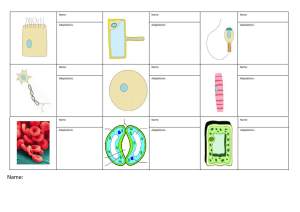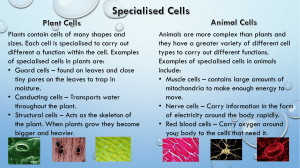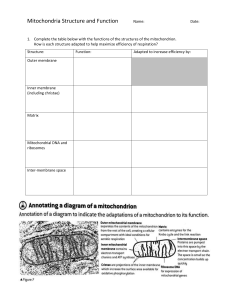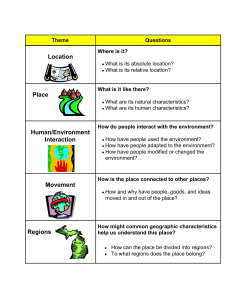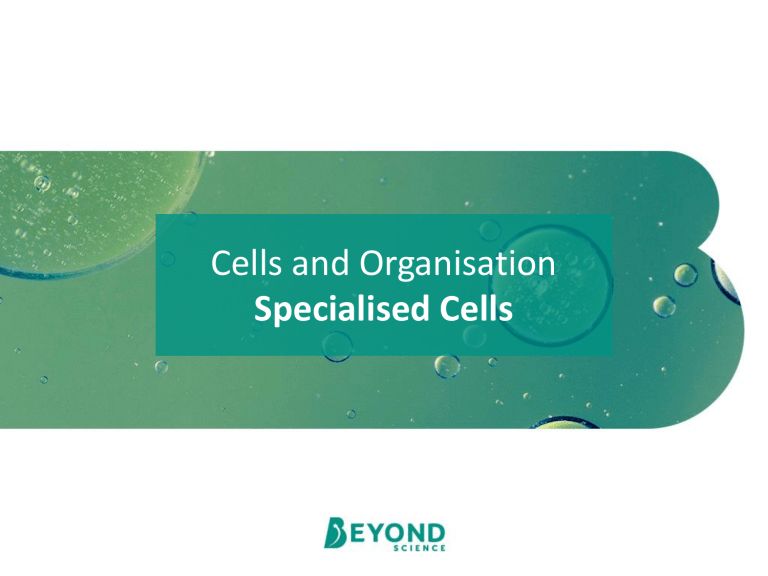
Cells and Organisation Specialised Cells Learning Objective To explain how cells are adapted for their functions. Success Criteria • To identify specialised cells from both plants and animals. • To summarise the adaptations of specialised cells from both plants and animals. • To link the adaptations of specialised cells to their roles in the organism. Cell Parts There is only one of me in the cell. I am found only in plant cells. I contain genetic information. I contain a pigment that absorbs sunlight. What am I? What am I? chloroplast nucleus There are usually lots of me in a cell. I am a jelly-like substance. I help to provide the cell with energy. I am where chemical reactions happen. What am I? What am I? mitochondria cytoplasm Specialised Cells Treasure Hunt There are lots of jobs that need doing in an organism, and so there are lots of types of cells. Each cell is specialised, which means its adapted so that it can carry out its job really well. The adaptations can mean the cells can look quite different from the typical animal and plant cells we have already looked at. There are information cards around the room that contain either adaptations, or functions, that the cells have to do. Find them, and see if you can use the pictures on your sheet to write them in the correct box. Root Hair Cell What is its function? To absorb water and minerals from the soil. How is it adapted to this function? Long root hair shape to fit between grains of soil so that it can reach water. Large surface area for diffusion of water and minerals into the cell. No chloroplasts due to being underground. Palisade Cell What is its function? To carry out photosynthesis and make food (glucose) for the plant. How is it adapted to this function? Lots of chloroplasts to absorb light to provide energy for photosynthesis. Tall, long shape and a large surface area to maximise the absorption of light. Sperm Cell What is its function? To travel to and fuse with an egg cell for fertilisation. How is it adapted to this function? Long tail for movement to the egg. Lots of mitochondria to release energy to allow the sperm to move the tail. Muscle Cell What is its function? To help the body to move. How is it adapted to this function? Contains bands of protein that change shape to contract and relax the muscle. Contains lots of mitochondria to provide energy for muscle contraction. Nerve Cell What is its function? To carry nerve impulses around the body. How is it adapted to this function? Long fibres allow it to carry electrical impulses up and down the body. Branching dendrites at each end to connect to other nerves or muscles. Ciliated Epithelial Cell What is its function? To move mucus with trapped dust and microorganisms away from the lungs. How is it adapted to this function? Tiny hairs called cilia to help to waft the mucus along the airways. Lots of mitochondria to release energy for cilia to move. Red Blood Cell What is its function? To transport oxygen around the body. How is it adapted to this function? Biconcave shape increases the surface area for the diffusion of oxygen. No nucleus so that there is more room for haemoglobin, which binds to oxygen molecules. White Blood Cell What is its function? To fight pathogens which cause disease. How is it adapted to this function? Some can change shape to squeeze out of blood vessels and engulf pathogens. Some can produce antibodies and antitoxins. Egg Cell What is its function? To be fertilised by the sperm cell. How is it adapted to this function? Cytoplasm contains nutrients for the developing embryo. The membrane changes after fertilisation to stop any more sperm getting in. Extended Writing For one specialised plant cell and one specialised animal cell, write a detailed paragraph that explains how the cell is adapted for its function. The cell is a (plant/animal) cell. It’s role in the organism is It is adapted to do this role by Another adaptation it has is Design a Specialised Cell Choose one of the cells below and have a go at designing it yourself. You need to think about what its role in the body is and then decide what adaptations you think it will need to be able to do that job. You could draw and label a diagram, or you could write a description, whatever suits you best! skin cell bone cell fat cell Splat! A cell that absorbs water. Splat! A cell that has lots of mitochondria. Splat! A plant cell that has no chloroplasts. Splat! A cell that needs a large surface area. Splat! A cell that can contract. Splat! A cell without a nucleus. Splat! A cell that you’d find in your airways. Splat! A cell that transports oxygen. Splat! A cell that transports oxygen.

